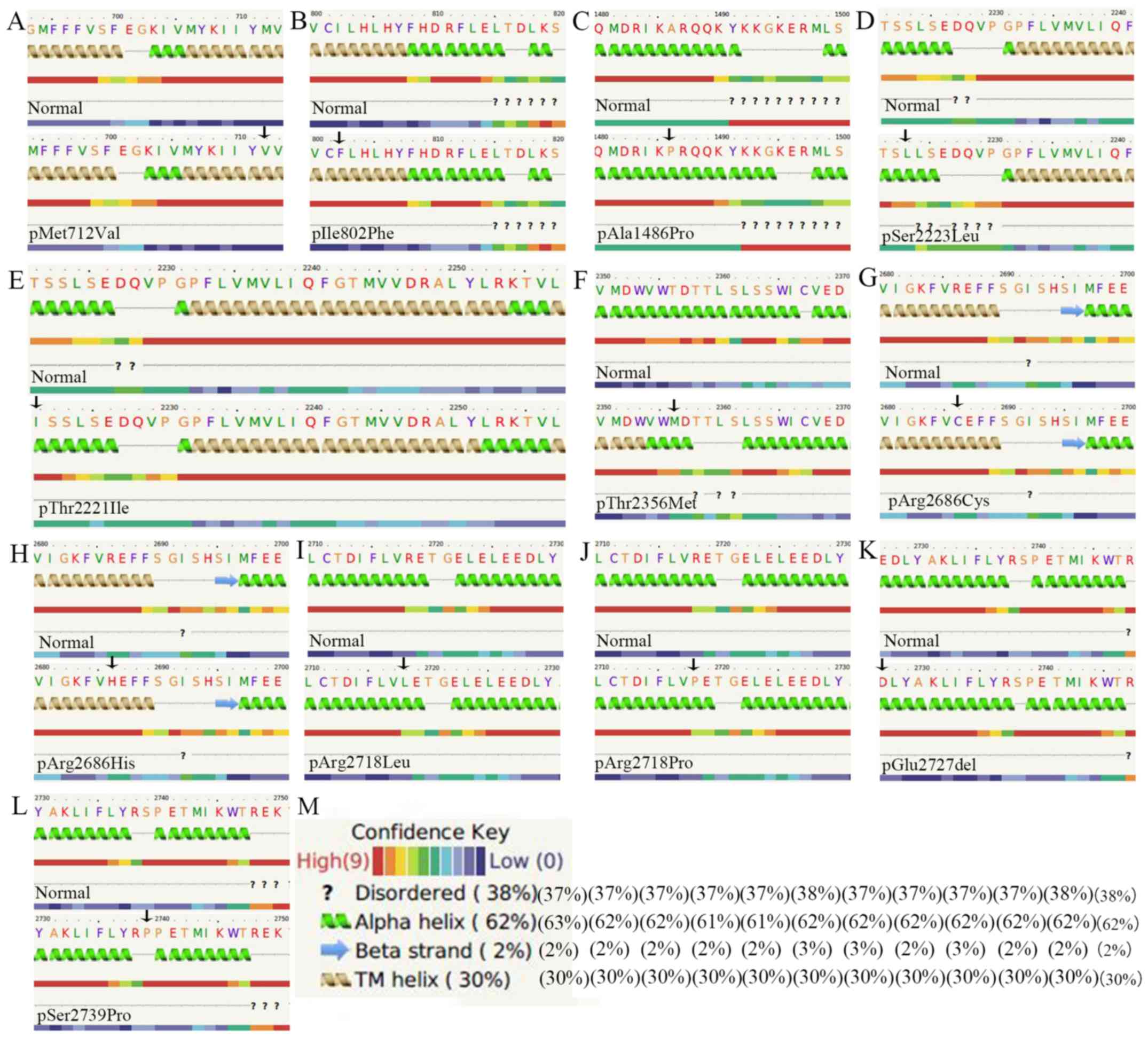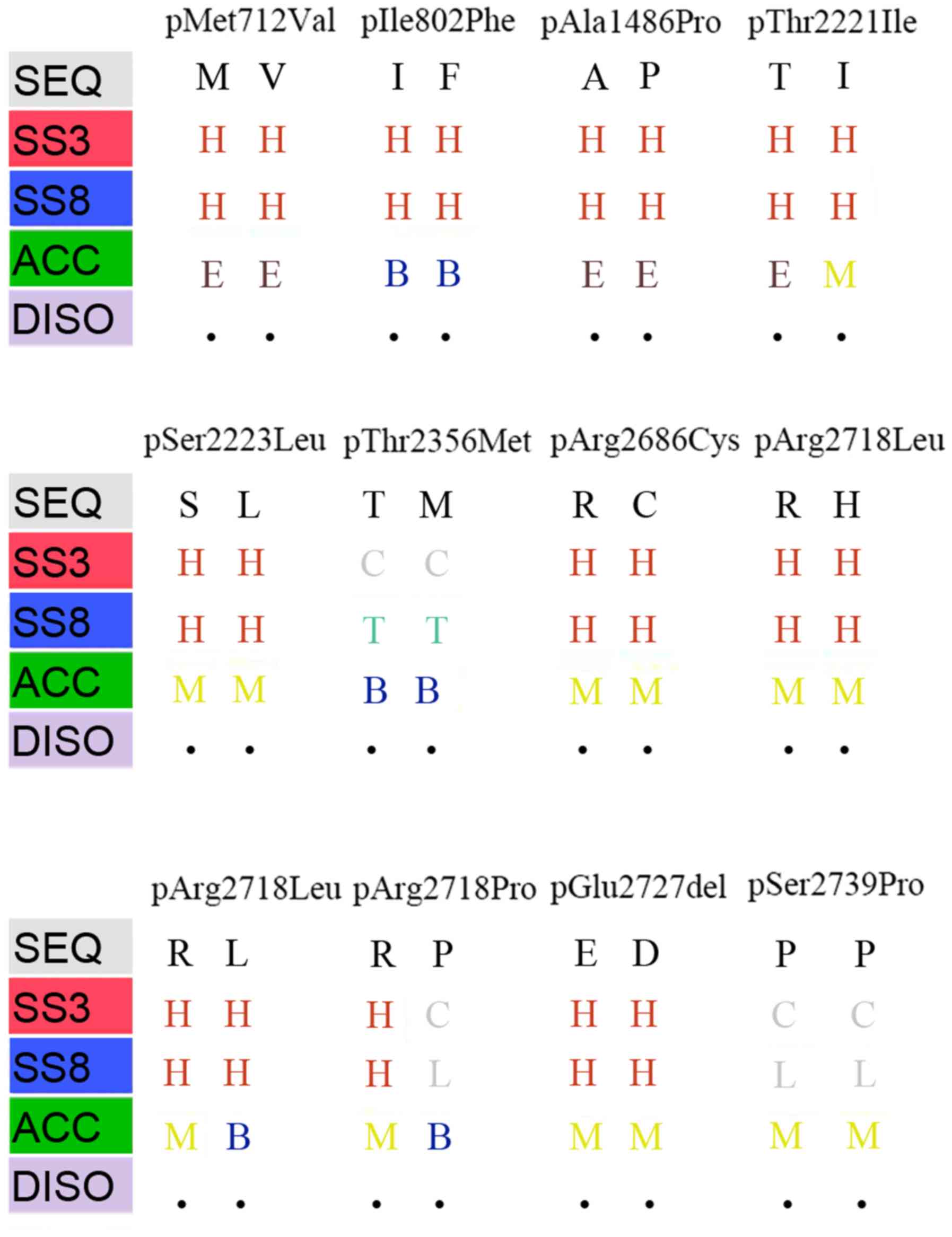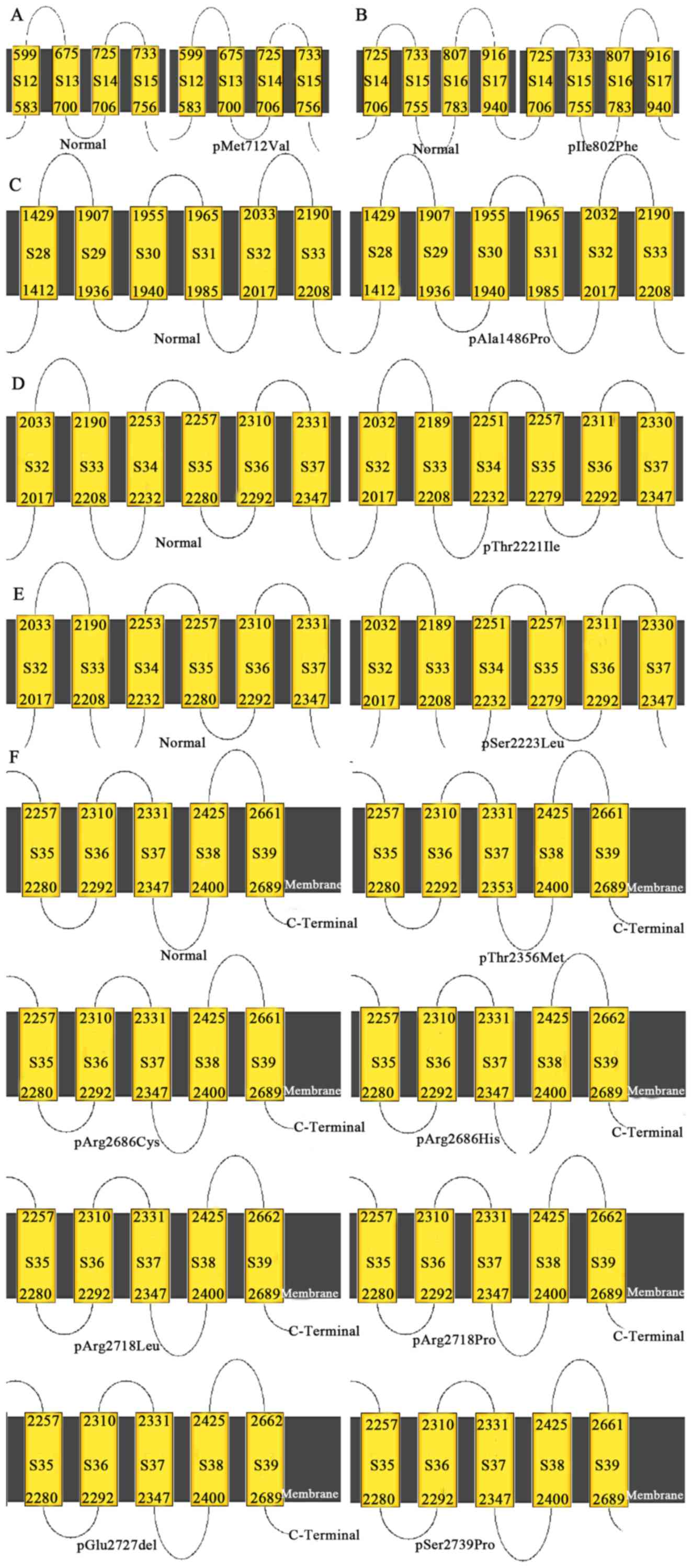|
1
|
Haliloglu G, Becker K, Temucin C, Talim B,
Küçükşahin N, Pergande M, Motameny S, Nürnberg P, Aydingoz U,
Topaloglu H and Cirak S: Recessive PIEZO2 stop mutation causes
distal arthrogryposis with distal muscle weakness, scoliosis and
proprioception defects. J Hum Genet. 62:497–501. 2017. View Article : Google Scholar : PubMed/NCBI
|
|
2
|
Alisch F, Weichert A, Kalache K, Paradiso
V, Longardt AC, Dame C, Hoffmann K and Horn D: Familial Gordon
syndrome associated with a PIEZO2 mutation. Am J Med Genet A.
173:254–259. 2017. View Article : Google Scholar : PubMed/NCBI
|
|
3
|
Delle Vedove A, Storbeck M, Heller R,
Hölker I, Hebbar M, Shukla A, Magnusson O, Cirak S, Girisha KM,
O'Driscoll M, et al: Biallelic loss of proprioception-related
PIEZO2 causes muscular atrophy with perinatal respiratory distress,
arthrogryposis, and scoliosis. Am J Hum Genet. 99:1206–1216. 2016.
View Article : Google Scholar : PubMed/NCBI
|
|
4
|
Okubo M, Fujita A, Saito Y, Komaki H,
Ishiyama A, Takeshita E, Kojima E, Koichihara R, Saito T, Nakagawa
E, et al: A family of distal arthrogryposis type 5 due to a novel
PIEZO2 mutation. Am J Med Genet A 167A. 1100–1106. 2015. View Article : Google Scholar
|
|
5
|
McMillin MJ, Beck AE, Chong JX, Shively
KM, Buckingham KJ, Gildersleeve HI, Aracena MI, Aylsworth AS,
Bitoun P, Carey JC, et al: Mutations in PIEZO2 cause Gordon
syndrome, Marden-Walker syndrome, and distal arthrogryposis type 5.
Am J Hum Genet. 94:734–744. 2014. View Article : Google Scholar : PubMed/NCBI
|
|
6
|
Coste B, Houge G, Murray MF, Stitziel N,
Bandell M, Giovanni MA, Philippakis A, Hoischen A, Riemer G, Steen
U, et al: Gain-of-function mutations in the mechanically activated
ion channel PIEZO2 cause a subtype of Distal Arthrogryposis. Proc
Natl Acad Sci USA. 110:4667–4672. 2013. View Article : Google Scholar : PubMed/NCBI
|
|
7
|
Chesler AT, Szczot M, Bharucha-Goebel D,
Čeko M, Donkervoort S, Laubacher C, Hayes LH, Alter K, Zampieri C,
Stanley C, et al: The role of PIEZO2 in human mechanosensation. N
Engl J Med. 375:1355–1364. 2016. View Article : Google Scholar : PubMed/NCBI
|
|
8
|
Mahmud AA, Nahid NA, Nassif C, Sayeed MS,
Ahmed MU, Parveen M, Khalil MI, Islam MM, Nahar Z, Rypens F, et al:
Loss of the proprioception and touch sensation channel PIEZO2 in
siblings with a progressive form of contractures. Clin Genet.
91:470–475. 2017. View Article : Google Scholar : PubMed/NCBI
|
|
9
|
Felsenthal N and Zelzer E: Mechanical
regulation of musculoskeletal system development. Development.
144:4271–4283. 2017. View Article : Google Scholar : PubMed/NCBI
|
|
10
|
Wu J, Lewis AH and Grandl J: Touch,
tension, and transduction - the function and regulation of piezo
ion channels. Trends Biochem Sci. 42:57–71. 2017. View Article : Google Scholar : PubMed/NCBI
|
|
11
|
Lee W, Leddy HA, Chen Y, Lee SH, Zelenski
NA, McNulty AL, Wu J, Beicker KN, Coles J, Zauscher S, et al:
Synergy between Piezo1 and Piezo2 channels confers high-strain
mechanosensitivity to articular cartilage. Proc Natl Acad Sci USA.
111:E5114–E5122. 2014. View Article : Google Scholar : PubMed/NCBI
|
|
12
|
Coste B, Mathur J, Schmidt M, Earley TJ,
Ranade S, Petrus MJ, Dubin AE and Patapoutian A: Piezo1 and Piezo2
are essential components of distinct mechanically activated cation
channels. Science. 330:55–60. 2010. View Article : Google Scholar : PubMed/NCBI
|
|
13
|
Nonomura K, Woo SH, Chang RB, Gillich A,
Qiu Z, Francisco AG, Ranade SS, Liberles SD and Patapoutian A:
Piezo2 senses airway stretch and mediates lung inflation-induced
apnoea. Nature. 541:176–181. 2017. View Article : Google Scholar : PubMed/NCBI
|
|
14
|
Li J, Hou B, Tumova S, Muraki K, Bruns A,
Ludlow MJ, Sedo A, Hyman AJ, McKeown L, Young RS, et al: Piezo1
integration of vascular architecture with physiological force.
Nature. 515:279–282. 2014. View Article : Google Scholar : PubMed/NCBI
|
|
15
|
Cahalan SM, Lukacs V, Ranade SS, Chien S,
Bandell M and Patapoutian A: Piezo1 links mechanical forces to red
blood cell volume. eLife. 4:2015. View Article : Google Scholar : PubMed/NCBI
|
|
16
|
Anderson EO, Schneider ER and Bagriantsev
SN: Piezo2 in cutaneous and proprioceptive mechanotransduction in
vertebrates. Curr Top Membr. 79:197–217. 2017. View Article : Google Scholar : PubMed/NCBI
|
|
17
|
Ranade SS, Woo SH, Dubin AE, Moshourab RA,
Wetzel C, Petrus M, Mathur J, Bégay V, Coste B, Mainquist J, et al:
Piezo2 is the major transducer of mechanical forces for touch
sensation in mice. Nature. 516:121–125. 2014. View Article : Google Scholar : PubMed/NCBI
|
|
18
|
Woo SH, Ranade S, Weyer AD, Dubin AE, Baba
Y, Qiu Z, Petrus M, Miyamoto T, Reddy K, Lumpkin EA, et al: Piezo2
is required for Merkel-cell mechanotransduction. Nature.
509:622–626. 2014. View Article : Google Scholar : PubMed/NCBI
|
|
19
|
Lemmers RJ, van den Boogaard ML, van der
Vliet PJ, Donlin-Smith CM, Nations SP, Ruivenkamp CA, Heard P,
Bakker B, Tapscott S, Cody JD, et al: Hemizygosity for SMCHD1 in
facioscapulohumeral muscular dystrophy type 2: Consequences for 18p
deletion syndrome. Hum Mutat. 36:679–683. 2015. View Article : Google Scholar : PubMed/NCBI
|
|
20
|
Carter E, Heard P, Hasi M, Soileau B,
Sebold C, Hale DE and Cody JD: Ring 18 molecular assessment and
clinical consequences. Am J Med Genet A 167A. 54–63. 2015.
View Article : Google Scholar
|
|
21
|
Miller DT, Adam MP, Aradhya S, Biesecker
LG, Brothman AR, Carter NP, Church DM, Crolla JA, Eichler EE,
Epstein CJ, et al: Consensus statement: Chromosomal microarray is a
first-tier clinical diagnostic test for individuals with
developmental disabilities or congenital anomalies. Am J Hum Genet.
86:749–764. 2010. View Article : Google Scholar : PubMed/NCBI
|
|
22
|
Wang S, Li W, Liu S and Xu J:
RaptorX-Property: A web server for protein structure property
prediction. Nucleic Acids Res. 44:W430–W435. 2016. View Article : Google Scholar : PubMed/NCBI
|
|
23
|
Källberg M, Wang H, Wang S, Peng J, Wang
Z, Lu H and Xu J: Template-based protein structure modeling using
the RaptorX web server. Nat Protoc. 7:1511–1522. 2012. View Article : Google Scholar : PubMed/NCBI
|
|
24
|
Kelley LA, Mezulis S, Yates CM, Wass MN
and Sternberg MJ: The Phyre2 web portal for protein modeling,
prediction and analysis. Nat Protoc. 10:845–858. 2015. View Article : Google Scholar : PubMed/NCBI
|
|
25
|
Vasquez V, Scherrer G and Goodman MB:
Sensory biology: It takes Piezo2 to tango. Curr Biol. 24:566–R569.
2014. View Article : Google Scholar
|
|
26
|
Saotome K, Murthy SE, Kefauver JM, Whitwam
T, Patapoutian A and Ward AB: Structure of the mechanically
activated ion channel Piezo1. Nature. 554:481–486. 2018. View Article : Google Scholar : PubMed/NCBI
|
|
27
|
Wu J, Young M, Lewis AH, Martfeld AN,
Kalmeta B and Grandl J: Inactivation of mechanically activated
piezo1 ion channels is determined by the C-terminal extracellular
domain and the inner pore helix. Cell Rep. 21:2357–2366. 2017.
View Article : Google Scholar : PubMed/NCBI
|
|
28
|
Held K, Gruss F, Aloi VD, Janssens A,
Ulens C, Voets T and Vriens J: Mutations in the voltage-sensing
domain affect the alternative ion permeation pathway in the TRPM3
channel. J Physiol. 2018. View
Article : Google Scholar : PubMed/NCBI
|

















